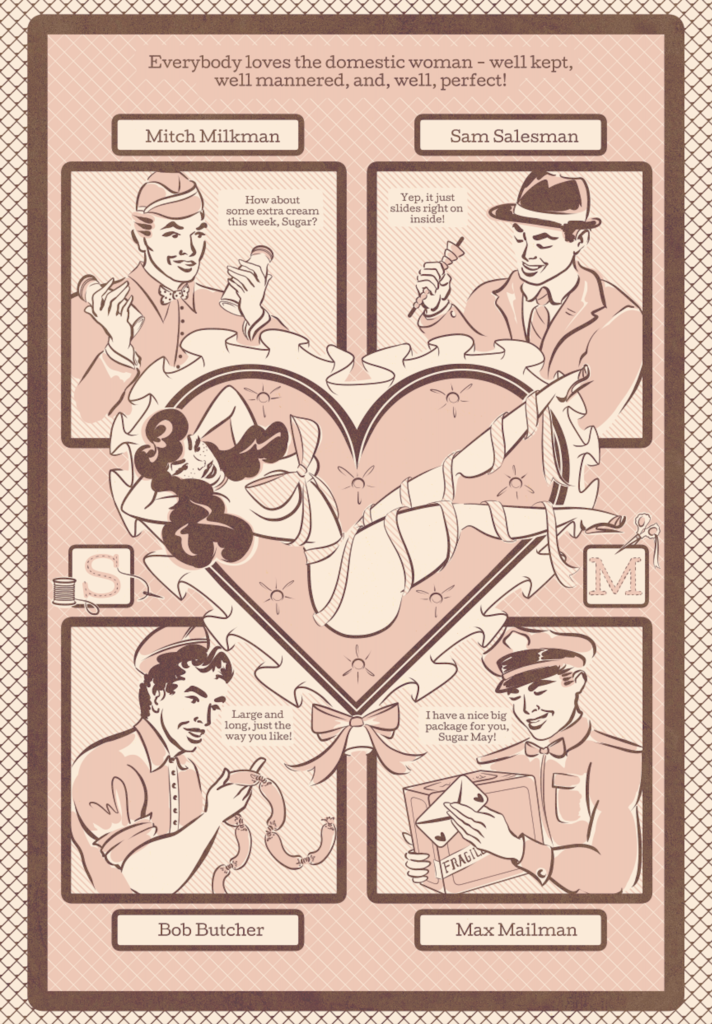Last updated on October 10, 2024
by S.E. Fleenor

Sugar May is a Good Wife by Sugar May is a comic that defies convention and definition. Part pin up fantasy, part science fiction exploration of ethics, this glorious, kinky comic presents readers with the ideal housewife who is game for anything–and always busy, busy, busy. She cooks! She cleans! She drops to her knees! But while you’re looking at her tempting curves, the fictional Sugar May is undermining the cisheteronormative patriarchy and making you beg for more. BoC relished the chance to interview the IRL Sugar May about her awesome comic, which is available on Gumroad.
Psst, if you love Sugar May is a Good Wife and can’t wait to read more, Sugar May has teased that she is currently working on her debut, vintage-themed graphic novel, so be on the look out!

Tell me about the cover. The logo, the font, the composition, everything is just seductive and at the same time…too perfect. The fictional Sugar May is voluptuous and bursting out of her slot in the utensil drawer, but she’s also convenient and shiny and something you can put away. What does the cover do for the wider story and what were you trying to convey?
I am enchanted by this idea of self-objectification. The traditional trope of pinup is delightful and silly, but often the woman is either unaware or unintentional in the conceit. Sugar May understands her own sexuality–and while she may very much play into the silly little housewife role, she also knows (and enjoys!) the inherent power of the submissive role. The fact that she is amongst everyday utensils, shiny, perfect, and convenient, simply waiting around to be used and then put away again is devious. She knows this. She likes this. The concept of female submission is extremely controversial in the current climate. It’s prone to misuse, misunderstanding, and offense. But one of the central themes of my work as an artist is to observe, play with, understand, and employ modalities of submission – and its paradoxically potent ability to empower.
The narrative voice throughout the comic is that of a salesperson. We don’t fully get why until we reach the last few pages, but throughout, this voice places the reader in the role of voyeur, consumer, devourer. Why did you want to put the reader in the hot seat so to speak?
Given Sugar May’s submissive nature, I am giving the audience the opportunity to assume a position of dominance. She is available for everyone–regardless of gender or orientation, and I want the reader to feel like they are allowed (encouraged!) to consume her…even if it’s not their normal cuppa tea. Plus, There’s a natural pastiche that comes from the sensationalized and oversimplified vintage sales pitch. It’s charming and, at first glance, almost innocent. Although, as with all advertising, there’s this subversive intention behind it…
You named the main character of this comic after yourself. I’m curious about what it is about yourself you want to explore, interrogate, or maybe embrace by doing so.
It’s all about roleplay–and that is to say, inhabiting an archetype that represents a part of the self that is edifying to your soul and beneficial to your growth. Role-play is simply creative exploration within boundaries. The very nature of it is limited, and, therefore, valuable. Sugar May the comic book character embodies uncensored feminine energy and spirit. She exists in a specific context that allows her to do so–away from the harsh realities of our crazy and confusing world. I get to play in her high femme character. I get to experience her joy, fantasies, perfection, and deviousness. Ideally, this gives the reader the opportunity to do the same – whether they want to be her or consume her.

The queerness of Sugar May is a Good Wife is undeniable and riotous. The fictional Sugar May might be sleeping with all the men in town, but she’s also banging their wives. She’s billed as the “Easy Breezy Nymphomatic Wonder Wife” and she’s what you call “delicately perverse” on your website. She’s kinky and horny and ideal in a way that seems to point a finger back at the cisheteronormative patriarchy. What does her hyper-femininity, sexuality, and je ne sais quoi tell us about queerness?
I see queerness as pure creativity – and creativity is a wild thing. It changes, it grows, it expands and teaches and inspires and connects. This is how queerness should be approached; as a vehicle for human connectivity. Queerness is a journey and process of being–just like the creation of art. I am not interested in the politicization of bodies, love, expression, play, terminology, or creative output. That only serves to diminish and divide humanity. I want to see more humanity. I want to see more creativity. I want to see people exploring their sexuality without needing to sling mud and shed blood. Sugar May portrays traditionally cisheteronormative-ly valuable traits–she’s pretty, submissive, dutiful, polite, and presentable–all qualities that can easily (and perhaps rightfully) be reviled by modern society. BUT! Her motivation is to elevate our human status to a level of intentionally and mindfully (boundaried and consensual!) constructed fantasy that is gratifying to everyone, no matter their gender or orientation. She is choosing to be a pretty little slut because that is what she wants, what she chooses, and what brings her (and her partners) creative fulfillment– not because it makes sense to a group of policy makers. It’s inclusive, in so far as you are welcome to join in, but exclusive in so far as it’s not seeking permission or approval. Sugar May is my kind of queer – that is to say, entirely personal, specific, idiosyncratic, intentional, and inappropriate.
In playing with the housewife who is more than housewife, robot who is more than robot trope, you interrogate the idea of who gets to be a person, who gets to have needs and desires. This comes up both in the way the fictional Sugar May is treated by the men and the way the other housewives view her: not as competition, but as something to be enjoyed. What does it mean to you to have a character who is sexualized and relishes in that sexuality?
Sexuality is creativity is power. If you take the time to understand and cultivate the archetype of your own sexuality, you equip yourself with ironclad poise; nobody can touch that. It belongs to you and is not reliant upon external affirmation. Sugar May represents the level of self-possession that comes with highly cultivated play; she knows herself. She can explore and enjoy her fetishistic nature because it is not needy and insecure. She wants both the men and women to connect to their deepest sexual desires (and, perhaps, their hidden selves), whether it is with her, or her robot replica.
When sexual energy is competitive, there’s imbalance–someone is going to lose. Therefore, sex (or any display of sexual intention) is intimidating, and ultimately weaponized. Specifically, women with strong sexual energy are often feared by other women. But Sugar May just wants lots of great sex–for herself, for couples, for you, with you. Clearly, she’s a nympho, but ultimately, your pleasure is her pleasure.
Sugar May is a Good Wife is funny and sexy and deeply profound. It’s playful and decidedly an homage to vintage pinup while also commenting on the way femininity, domesticity, and sexuality have been treated historically and still are. What does mixing the levity and the gravity allow you to access that you might not be able to without both?
Sex is a heady cocktail of both. It’s inherently serious and dangerous and threatening, while also being delightful and playful and whimsical. That is its enduring appeal.
It is also impossibly complex; the socio-political and historical implications are inextricably interwoven, and cannot be ignored. Saying that, Sugar May Is a Good Wife is obviously over-simplified; I do not address any real-world consequences or post modern dilemmas. This work is giving a context to and a license for the reader to explore and enjoy the fetishes therein. Fetishes, by their very nature, are the ultimate in levity-meets-gravity; the dark and problematic inner workings of our personal taboos literally rubbing up against the exquisite mirth of indulgent pleasure seeking.
I’m looking back on the difficult past of femininity, domesticity, and sexuality with sobriety, and choosing to reclaim it by artfully playing with its kinkability.

In many ways Sugar May is a Good Wife seems to be engaging with not just the topics above, but with an existing body of literature, film, TV. I’m thinking Ex-Machina, Humans, Stepford Wives, and comics like SFSX, particularly Volume 2: Terms of Service (I love Stacie). Did any of these titles come into play when you were creating your comic and if so, how? Are there others you think of Sugar May is a Good Wife being in conversation with?
Yes! I’ve got a bit of a kink for robots, and all of these previous works have been wonderful inspiration. Mine definitely differs in that I’m not looking at the existential crisis or dystopian element, but, rather, in that compelling intersection where human sexuality and artificial intelligence converge. I actually find the current upswing of AI inflitration totally terrifying and unethical, so perhaps besides my indecent predilection for kinky robots, I’m trying to find humanity in the great big black box of the technologically dominated future.
I think Sugar May could sit down and have a salient conversation with the incredibly sexy, feminine, and retro robobabes of Hajime Soroyama. But then, there is also the soft and vulnerable side of sexual/relationship exploration that I can envision robots being extremely good with. The film Her offers a sweet and genuine perspective on this. One of my most favorite films is Lars and the Real Girl – it’s about a doll, not a robot, and it’s not even sexual, but there’s definitely something beyond titillation in the whole idea around finding human connection in a non-human relationship.
To go one further, I even think Star Trek has a place at the table; the good and wholesome android character Data is subservient, loyal, dutiful, and extremely useful. In the show, he inspires ethical debates about what it means to be human while fighting the intergalactic good fight. In real life, women across the world literally and actually fell in love with him.
There’s something in all of this.
Sugar May is a Good Wife has a distinct style that blends vintage pin ups, erotica, and comics. How did you develop your style and why do you focus on what you call “delicious and devious depictions of kinky and queer sexuality” in your art?
When I was young, my mother did not let me watch very much TV, and what she did allow was usually from the 40s or 50s. That vintage aesthetic is seared into my mind. The beauty, the artifice, the elegance and femininity – there is no rival to it. Sugar May is as much I Love Lucy and American in Paris as she is Eric Stanton’s whoring housemaid. Beautification is one of my core motivations as an artist, and I find it a postmodern tragedy that so much contemporary art/sex/fashion/etc is just fast and cheap and ugly. That golden era is still wonderful because aesthetic consideration held so much value.
I like to think of my work as a chocolate box; at first glance, it’s this delicate and lovely thing, to be relished (even though you kind of know you shouldn’t). Each morsel is bliss…and it only makes you want more. And, perhaps, you have a bit more than you should. And even though you put the lid back on, you will be thinking of what’s in each and every one of those dainty little paper cups until the temptation is too much. I want to seduce you. And you will be happy about it.
So, while I may be playing with ideas that are not fit for polite conversation, it’s still very important to me that they are beautifully presented. High femme is the sexiest, whether it’s on women, men, robots, or toasters. And queerness is just creativity – an open mind and spirit to sexual exploration. That is something I believe belongs to everyone – so if my frilly pink world brings you one step closer to that, then my stylistic seductress has succeeded.
If readers want to learn more about you and your comic work, where can they find you online?
You may find me and my work on Instagram @sugarmayisagoodwife and my website sugarmayisagoodwife.com.

Sugar May is a comics artist, pinup illustrator, and art model. She works in a purely vintage aesthetic, and devotes herself to delicious and devious depictions of kinky and queer sexuality through transmedia storytelling.
S.E. Fleenor is a writer and editor who wears many hats. They are a freelance developmental editor, editor of Decoded Pride literary magazine, co-founder of QueerSpec.com, and their essays, creative nonfiction, and fiction appear in various publications including The Independent, Buzzfeed Reader, VICE, Electric Literature, Xtra Magazine, them.us, Upworthy, Denver VOICE, and many more. They teach online and in-person writing workshops, and co-host the comics and pop culture podcast Bitches on Comics, which has over 65,000 downloads, putting us in the top 15% of all podcasts. They are a head writer and voice actor for the horror narrative fiction podcast Tales of the Sapphire Bay Hotel, and their short story “Anomalous” was adapted to audio through Decoded Horror Channel’s Graveyard Orbit. They are a member of GALECA: the society of LGBTQ entertainment critics
